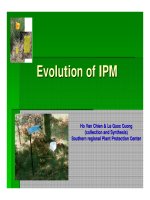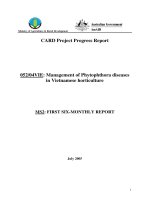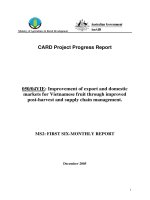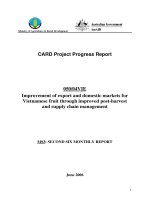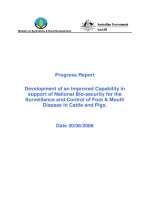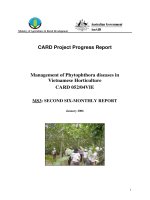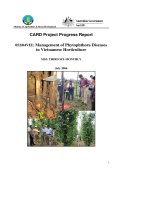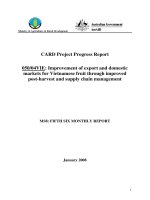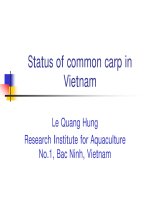Báo cáo nghiên cứu khoa học: " EFFECT OF INITIAL SULFUR DIOXIDE CONTENT IN MUST ON THE KINETICS OF WINE PRIMARY FERMENTATION, USING YEAST IMMOBILIZED IN CALCIUM ALGINATE GEL" pptx
Bạn đang xem bản rút gọn của tài liệu. Xem và tải ngay bản đầy đủ của tài liệu tại đây (371.95 KB, 7 trang )
TẠP CHÍ PHÁT TRIỂN KH&CN, TẬP 11, SỐ 09 - 2008
Trang 83
EFFECT OF INITIAL SULFUR DIOXIDE CONTENT IN MUST ON THE
KINETICS OF WINE PRIMARY FERMENTATION, USING YEAST
IMMOBILIZED IN CALCIUM ALGINATE GEL
Ton Nu Minh Nguyet, Le Ngoc Lieu, Nguyen Thi Hien Luong, Le Van Viet Man
University of Technology, VNU-HCM
(Manuscript Received on June 10
th
, 2007, Manuscript Revised April 29
th
, 2008)
ASTRACT: Effect of initial sulfur dioxide content in must on the kinetics of wine
primary fermentation, using yeast immobilized in calcium alginate gel was examined. Initial
sulfur dioxide content in must was adjusted from 12ppm to 312ppm. Our experimental results
indicated that the maximum specific growth rate of the immobilized yeast was 1-2 times less
than that of the free yeast. On the contrary, the sugar uptake rate and ethanol production rate
of the immobilized yeast were 1.23-1.90 times and 1.22-1.81 times, respectively, more than
those of the free yeast. The volatile acid content and pH value of the final wine fermented by
immobilized yeast were lower. Thus, the organoleptic properties and biological stability of the
wine were ameliorated. In general, the yeast immobilized in calcium alginate gel was more
resistant to sulfur dioxide than the free yeast.
Key words: alginate, immobilization, fermentation, sulfur dioxide, yeast
1. INTRODUCTION
Cell immobilization in alcoholic fermentation is a rapidly expanding research area because
of its attractive technical and economic advantages compared to the free cell system such as
enhanced fermentation productivity, feasibility of continuous processing, cell stability and
lower costs of recovery and recycling processing as well as tolerance to disadvantage factors
[5,6,8].
Although many immobilization supports have been proposed for use in wine-making,
industrial application of the technology is still uncertain and should be investigated. This is
mainly due to difficulty in finding a low-cost material that is abundant, durable, of food-grade
purity and has the ability to be preserved for a long period [5].
Alginate has been considered as a potential support for cell immobilization because of
simple immobilization procedure, high cell density in the gel and non-toxic carrier [1,7].
The aim of this study is to investigate the effect of initial sulfur dioxide content in must on
the kinetics of wine primary fermentation, using yeast immobilized in calcium alginate gel.
2. MATERIALS AND METHODS
Yeast:
A Saccharomyces cerevisiae strain of Food Microbiological Laboratory Collection
(Ho Chi Minh City University of Technology) was used in the present study. Grape juice was
used for yeast multiplication. Preculture was prepared by two successive inoculations: 1) in
250ml erlenmeyer shake flask containing 100ml of grape juice for 24 hours, and 2) in a 2000
ml erlenmeyer shake flask containing 500ml of grape juice. For both periods, the inoculum
was grown at 28
o
C and 250rpm.
Alginate: Sodium alginate was supplied by Biotechnology Center, Nha Trang University
of Fisheries. The viscosity (2% alginate solution, 25
o
C) was 423.6cp.
Science & Technology Development, Vol 11, No.09 - 2008
Trang 84
Must: Fermentation medium was prepared from Red Cardinal grape (Ninh Thuan
province, Vietnam). It was adjusted to 240g/L of glucose, 195ppm of ammonium nitrogen, pH
4.0. Initial sulfur dioxide content was alternatively adjusted to 12ppm, 112ppm, 212ppm,
216ppm and 312ppm.
Yeast immobilization: The immobilization procedure was carried out by the traditional
external gelation method [1]. Yeast concentration was 25x106 cells/ml of gel bead.
Fermentation: was conducted at 22-25
o
C in an erlenmeyer containing 500ml of grape
must. The inoculating rate was 5x10
6
cells/ml. Free yeast cells were used in the control
sample.
Analytical methods:
Yeast cell number was quantified by haemocytometry, using Thoma counting chamber.
For counting yeast cells inside the gel beads, the beads were dissolved in a 2%w/v Na-EDTA
solution [1].
Reducing sugar content was determined by spectrophotometric method, using 3,5-
disalycylic acid reagent [4].
Ethanol concentration was determined by a method based on distillation and density
quantification [4].
Volatile acid content was measured by the following method: Firstly, wine sample was
steam-distilled. Then the obtained distillate was titrated by the 0.1M NaOH solution [9].
Statistical treatment
The presented results were the average of three independent experiments. The obtained
results were subjected to analysis of variance (ANOVA), p<0.05 using Statgraphics plus,
version 3.2.
3. RESULTS AND DICUSSION
3.1.Effect of initial SO
2
content in must on yeast growth
Figure 1 showed that when the sulfur dioxide content in must increased from 12 to
112ppm, the maximum specific growth rate of the free and immobilized yeasts increased
slightly, the maximum cell density of the free and immobilized yeasts augmented aproximately
19% and 5%, respectively. In wine fermentation, sulfur dioxide has been used for controlling
oxidation reactions and restricting the growth of indigenous micro flora in must [2]. According
to Fleet (1993), increase in sulfur dioxide content in must reduced the multiplication of wild
yeasts and bacteria [2]. The growth of the wine yeast was therefore improved.
However, when the initial sulfur dioxide content in must increased from 112 to 312ppm,
the maximum specific growth rate of the free and immobilized cells decreased aproximately
14 times and 7 times, respectively; the maximum cell density of the free and immobilized
yeasts reduced aproximately 1.35 times and 1.24 times, respectively. It can be explained that
when the initial sulfur dioxide content in must was high enough, the wine yeast was also
inhibited.
When the initial sulfur dioxide content in must varied from 12 to 112ppm, the maximum
specific growth rate and maximum cell density of the free yeast were higher than those of the
immobilized yeast. On the contrary, when the initial sulfur dioxide content varied from 212 to
312ppm, the difference in maximum specific growth rate and maximum cell density in both
free and immobilized yeast cultures were nearly similar. Therefore, the immobilized cells were
more resistant to sulfur dioxide than the free cells. It was due to protection role of alginate gel
for the immobilized yeast.
TẠP CHÍ PHÁT TRIỂN KH&CN, TẬP 11, SỐ 09 - 2008
Trang 85
0
0.1
0.2
0.3
0.4
0.5
0.6
0.7
12 112 212 262 312
SO
2
content (ppm)
Maxi mum specific growth rate (1/h)
170
185
200
215
230
245
260
Maxi mum cell density (10
6
cells/mL)
Figure 1. Effect of initial SO
2
content of must on maximum specific growth rate and maximum cell
density. Symbol: (
), maximum specific growth rate, ( ) maximum cell density. Opened symbol:
free yeast, filled symbol: immobilized yeast
3.2.Effect of initial SO
2
content in must on the fermentation time
In this experiment, the fermentation was considered as completed when the fermentation
productivity reached approximately 97%. Fermentation productivity was the ratio between the
reducing sugar content consumed by yeast during the fermentation and the initial reducing
sugar content in the medium. Our results showed that the higher the sulfur dioxide content in
must, the longer the fermentation time (Table 1). When the sulfur dioxide content in must
increased from 12 to 112ppm, the change in fermentation time was insignificant. However,
when the content of sulfur dioxide augmented from 112 to 312ppm, the fermentation time of
the free and immobilized yeasts increased. It should be noted that the fermentation time of the
immobilized yeast was always shorter than that of the free yeast in all cases. Therefore, yeast
immobilization in calcium alginate gel improved its fermentation activity.
Table 1.Effect of initial SO
2
content of must on the fermentation time
Fermentation time (h) SO2 (ppm)
Immobilized yeast Free yeast
12
112
212
262
312
84
± 3,61a
84,5
± 3,04a
100,8
± 2,97b
100,3
± 3,54b
184,8
± 3,70e
112,8
± 2,31c
117,6
± 3,33c
132
± 3,61d
196,8
± 3,54f
228
± 4,36g
Various superscripts indicate significant
differences (p < 0.05)
3.3.Effect of initial SO
2
content in must on the fermentation rate
The fermentation rate was evaluated by the average sugar uptake rate and average ethanol
production rate of yeasts. Figure 2 and 3 presented the obtained results. Analysis of variances
Science & Technology Development, Vol 11, No.09 - 2008
Trang 86
showed that when the sulfur dioxide content in must increased from 12 to 112ppm, both sugar
uptake rate and ethanol production rate of the immobilized and free yeasts changed
insignificantly. On the contrary, when the sulfur dioxide content augmented from 112 to
312ppm, the fermentation rate of the immobilized and free cells decreased approximately 50%
of initial value. In all cases, the average sugar uptake rate and average ethanol production rate
of the immobilized yeast were always higher than those of the free yeast.
0
0.5
1
1.5
2
2.5
3
12 112 212 262 312
SO
2
content (ppm)
Average sugar uptake (g/L/h)
Figure 2. Effect of initial SO
2
content of must on average sugar uptake rate. Symbol: ( ) immobilized
yeast, (
) free yeast.
0
0.2
0.4
0.6
0.8
1
1.2
1.4
12 112 212 262 312
SO
2
content (ppm)
Average ethanol production rate (g/L/h)
Figure 3. Effect of initial SO
2
content of must on average sugar uptake rate. Symbol: ( ) immobilized
yeast, (
) free yeast.
3.4.Effect of initial SO
2
content in must on pH and volatile acid content in the
product
Figure 4 showed that increase in sulfur dioxide content in must augmented the pH value at
the end of the primary fermentation. In addition, the pH value of wine fermented by the
immobilized yeast was always lower than that in the control sample.
TẠP CHÍ PHÁT TRIỂN KH&CN, TẬP 11, SỐ 09 - 2008
Trang 87
3.3
3.4
3.5
3.6
3.7
3.8
3.9
4
4
.
1
0 24 48 72 96 120 144 168 192 216
Time (h)
p
H
Figure 4: Change in pH value during must fermentation. The initial sulfur dioxide content in must was
varied: 12ppm (
), 112ppm ( ), 212ppm ( ), 262ppm ( ), 312ppm (+×). Opened symbol and
(+): free yeast, filled symbol and (x): immobilized yeast.
0
0.005
0.01
0.015
0.02
0.025
0.03
0.035
0.04
0 24 48 72 96 120 144 168 192 216
Time (h)
Volati le aci d content (g aceti c aci d/100mL)
Figure 5. Change in volatile acid content during must fermentation. The initial sulfur dioxide content in
must was varied: 12ppm (
), 112ppm ( ), 212ppm ( ), 262ppm ( ), 312ppm (+×). Opened
symbol and (+): free yeast, filled symbol and (x): immobilized yeast.
Figure 5 indicated that volatile acid content augmented during the fermentation. When the
initial sulfur dioxide in must was 112ppm, the volatile acid content in the produced wine was
the lowest. It can be explained that in must with low sulfur dioxide content, the growth of non-
Saccharomyces yeasts and bacteria that produced volatile acid was ameliorated. Thus the
volatile acid content in the final product increased. In addition, some genera if wild yeasts such
as
Kloeckera, Candida were resistant to sulfur dioxide. According to Heard G.M. et al.,
(1993), the growth of these wild yeasts was not inhibited by total SO
2
concentrations of 100-
Science & Technology Development, Vol 11, No.09 - 2008
Trang 88
150ppm or higher [3]. So in some cases, high sulfur dioxide content in must did not
completely inhibit the wild yeasts and this phenomenon increased the volatile acid content in
the culture.
It can be noted that the volatile acid content of the produced wine fermented by the
immobilized yeast was always lower than that in the control sample. Thus the application of
immobilized yeast in wine making improved the sensory properties of the product.
4. CONCLUSION
Yeast immobilization in calcium alginate gel increased the fermentation activity of cells as
well as their resistance to sulfur dioxide. In wine making, the immobilized yeast had higher
fermentation activity than the free yeast, especially when must contains high initial sulfur
dioxide content. So the application of immobilized yeast in wine fermentation was very
potential when initial must needs to be processed with high sulfur dioxide content for
inhibiting wild yeast and bacteria.
ẢNH HƯỞNG HÀM LƯỢNG SULFUR DIOXIDE BAN ĐẦU TRONG DỊCH
NHO ĐẾN ĐỘNG HỌC QUÁ TRÌNH LÊN MEN CHÍNH TRONG SẢN XUẤT
RƯỢU VANG, SỬ DỤNG NẤM MEN CỐ ĐỊNH TRONG GEL ALGINATE
CALCIUM
Tôn Nữ Minh Nguyệt, Lê Ngọc Liễu, Nguyễn Thị Hiền Lương, Lê Văn Việt Mẫn
Trường Đại học Bách khoa, ĐHQG-HCM
TÓM TẮT: Bài báo này khảo sát sự ảnh hưởng của hàm lượng sulfur dioxide ban đầu
trong dịch nho đến động học quá trình lên men chính trong sản xuất rượu vang, sử dụng nấm
men cố định trong gel calcium alginate. Hàm lượng sulfur dioxide ban đầu trong dịch nho
được hiệu chỉnh trong khoảng từ 12 đến 312ppm. Kết quả thực nghiệm cho thấy tốc độ sinh
trưởng riêng cực đại của nấm men cố định thấp hơn từ 1-2 lần so với n
ấm men tự do. Ngược
lại, tốc độ sử dụng đường và tốc độ sinh tổng hợp ethanol của nấm men cố định lần lượt cao
hơn từ 1.23-1.90 lần và 1.22-1.81 lần so với nấm men tự do. Hàm lượng acid bay hơi và giá trị
pH của rượu vang được lên men bằng nấm men cố định thì thấp hơn. Do đó, các tính chất cảm
quan và độ bền sinh học của rượu vang được cải thiệ
n. Nhìn chung, nấm men cố định trong
gel calcium alginate bền với tác nhân sulfur dioxide hơn so với nấm men tự do.
REFERENCES
[1]. Bui T.H., Le Van V.M., Growth and metabolic activity of immobilized yeast cells in
calcium alginate gel during alcoholic fermentation,
Proceedings of Regional
Symposium ob Chemical Engineering 2005
, Science and Technics Publishing House,
Hanoi, pp.153-157 (2005)
[2].
Fleet G.H. Wine microbiology and biotechnology, Harwood academic publishers,
Switzerland (1993)
TẠP CHÍ PHÁT TRIỂN KH&CN, TẬP 11, SỐ 09 - 2008
Trang 89
[3]. Heard G.M., Fleet G.H., The effect of sulfur dioxide on yeast growth during natural
and inoculated wine fermentation,
The Australian and New Zealand Wine Industry
Journal
, Vol. 3, pp57-60 (1988)
[4].
Helrich K. Official methods of analysis of the Association of Official Analytical
Chemists
, AOAC Inc., Virginia (1992)
[5].
Kourkoutasa, Y., Bekatoroua, A., Banatb, I.M., Marchantb, R., Koutinasa, A.A.,
Immobilization technologies and support materials suitable in alcohol beverages
production: a review,
Food Microbiology, Vol.2, pp. 377-397 (2004)
[6].
Melzoch, Y., Rychtera, M, Effect of immobilization upon the properties and behavior
of
Saccharomyces cerevisiae cells, Journal of Biotechnology, Vol. 32, pp. 59-65
(1994)
[7].
Silva, S., Ramon-Portugal, F., Silva, P., Texeira, M.F., Strehaiano, P., Use of
encapsulated yeast for the treatment of stuck and sluggish fermentations,
Journal
International Science du Vigne et Vin,
Vol. 36, pp. 161–168 (2002)
[8].
Tsakiris, A., Bekatorou, A., Psarianos, C., Koutinas, A.A., Marcha, R., Banat, I.M.,
Immobilization of yeast on dried raisin berries for use in dry white wine-making,
Food Chemistry, Vol. 87, pp. 11-15 (2004)
[9].
Zoeklein, B., Fugelsang, K., Gump, B., Nury, F Volatile acidity, Production Wine
Analysis
, NewYork, Van Norstrand Reinhold, pp. 105 – 110 (1990)
